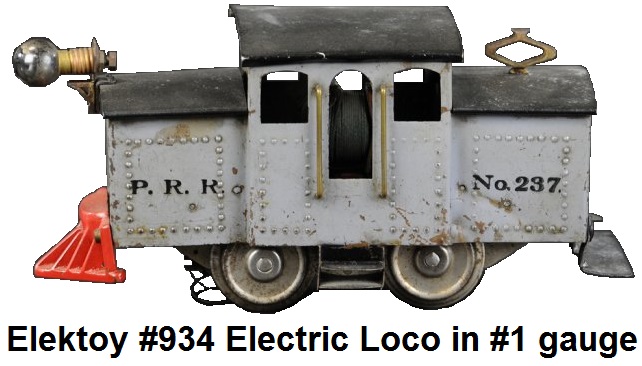 The Elektoy train line was a #1 gauge series of tinplate manufactured in a small factory in Harrison,
New Jersey, during a brief time period in the early 1900's, and has become a highly sought after and
collectible commodity. The trains were produced in limited runs and since there are only two years of known
cataloguing, and no advertising on a national basis was ever performed, there is not a great deal of
information available on this company. The Hoops family (a father-son combination) initially operated
the firm as Metal Specialties from 1875 to 1910, making various metal goods
with a wide variety of uses. In 1910 the name Elektoy Train Line was patented. Shortly
before any trains were produced, ownership passed to the J. K. Osborn Mfg. Co. according to Louis
Hertz. Hertz believed that the actual dates of train production were 1911-1913 (see "Riding The
Tinplate Rails" and "Collecting Model Trains" both by Hertz). Elektoy catalogs have been found
for the years 1912 and 1913 but no other paper trail is known to exist.
The Elektoy train line was a #1 gauge series of tinplate manufactured in a small factory in Harrison,
New Jersey, during a brief time period in the early 1900's, and has become a highly sought after and
collectible commodity. The trains were produced in limited runs and since there are only two years of known
cataloguing, and no advertising on a national basis was ever performed, there is not a great deal of
information available on this company. The Hoops family (a father-son combination) initially operated
the firm as Metal Specialties from 1875 to 1910, making various metal goods
with a wide variety of uses. In 1910 the name Elektoy Train Line was patented. Shortly
before any trains were produced, ownership passed to the J. K. Osborn Mfg. Co. according to Louis
Hertz. Hertz believed that the actual dates of train production were 1911-1913 (see "Riding The
Tinplate Rails" and "Collecting Model Trains" both by Hertz). Elektoy catalogs have been found
for the years 1912 and 1913 but no other paper trail is known to exist.

Elektoy made #1 gauge, three rail, all electric trains with the intention to compete in the middle
of the toy train market. At the time, the lower end of the market was primarily 'O' gauge trains made
by Ives and German imports. The upper end of the
market included Ives, Märklin and Bing #1 gauge
and Lionel's Standard gauge trains. #1 gauge is 1 ¾
inches (1.75 inches or 44.45 mm) between the outside rail heads, making it larger
than 'O' gauge but slightly smaller than wide (Standard) gauge. It is also often referenced
as being 1 ⅞ inches between the outside rails.
The scale for #1 gauge is typically ⅜ inch to 1 foot. In those days,
train sizes were defined using gauge, rather than scale. The four primary gauges having standards
adopted were #0 (commonly called 'O' gauge today), #1, #2 and #3.
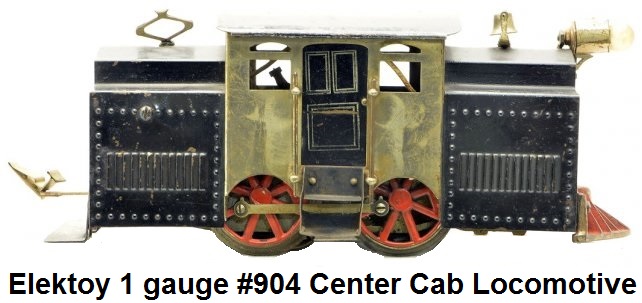 Elektoy only created 0-4-0 type locomotives in electric and steam outline. The Elektoy line was
characterized by very low prices. The #904 electric outline type loco, which was made of brass and steel, finished in
4 colors, equipped with side rods, reverse, and a headlight, sold for $6.00, complete with a 38" circle of track
(10 pieces). It was hand painted in maroon, gray and black. Livery was for the PRR, and the cab was numbered #9.
It was modeled after the S-1 Electric prototypes that ran on the New York Central RR during this era. The nickel
plated cab featured sliding doors. The 1912 catalog stated that the illuminated headlight could be "turned on and
off simply by unscrewing the lamp a half turn, or vice-versa". The lettered numbers on Elektoy locos and cars did not
correspond to actual catalog numbers.
Elektoy only created 0-4-0 type locomotives in electric and steam outline. The Elektoy line was
characterized by very low prices. The #904 electric outline type loco, which was made of brass and steel, finished in
4 colors, equipped with side rods, reverse, and a headlight, sold for $6.00, complete with a 38" circle of track
(10 pieces). It was hand painted in maroon, gray and black. Livery was for the PRR, and the cab was numbered #9.
It was modeled after the S-1 Electric prototypes that ran on the New York Central RR during this era. The nickel
plated cab featured sliding doors. The 1912 catalog stated that the illuminated headlight could be "turned on and
off simply by unscrewing the lamp a half turn, or vice-versa". The lettered numbers on Elektoy locos and cars did not
correspond to actual catalog numbers.
 Elektoy steam type locomotives (#903 & #905) were made entirely of metal and included a bell, an octagonal
headlight with pedestal, rivet detail on the steamchest, boiler and bunker. The Elektoy name is engraved
on the steam chest. The steam type loco bodies were removable without requiring the use of any tools.
This was accomplished by unscrewing the locomotive's smokestack, then the boiler could be swiveled back on
a hinge located under the cab. This allowed access to the motor, frame, and running gear to facilitate
replacement of brushes, oiling of gears and bearings, and cleaning directly from the top of the motor
(Voltamp - Boucher trains provided this identical
feature). The same motor and running gear powered every locomotive in the line. It had a six-pole armature, a horseshoe field,
steel laminations, a bronze commutator, and mica insulated gauze brushes. Motors were equipped with reverse
switches, were well made of good materials, ran very smoothly and quietly, and pulled long strings of cars.
Locomotive wheels were made from hollow stampings, with eight wide spokes. Tenders employed 8 wheel trucks,
and imitation coal piles. The Elektoy #905 steam outline locomotive was made in brass
and appeared similar to Lionel's #7 locomotive. However, unlike the #7 or #6 special, the
Elektoy brass engine is the most common one to find of the series.
Elektoy steam type locomotives (#903 & #905) were made entirely of metal and included a bell, an octagonal
headlight with pedestal, rivet detail on the steamchest, boiler and bunker. The Elektoy name is engraved
on the steam chest. The steam type loco bodies were removable without requiring the use of any tools.
This was accomplished by unscrewing the locomotive's smokestack, then the boiler could be swiveled back on
a hinge located under the cab. This allowed access to the motor, frame, and running gear to facilitate
replacement of brushes, oiling of gears and bearings, and cleaning directly from the top of the motor
(Voltamp - Boucher trains provided this identical
feature). The same motor and running gear powered every locomotive in the line. It had a six-pole armature, a horseshoe field,
steel laminations, a bronze commutator, and mica insulated gauze brushes. Motors were equipped with reverse
switches, were well made of good materials, ran very smoothly and quietly, and pulled long strings of cars.
Locomotive wheels were made from hollow stampings, with eight wide spokes. Tenders employed 8 wheel trucks,
and imitation coal piles. The Elektoy #905 steam outline locomotive was made in brass
and appeared similar to Lionel's #7 locomotive. However, unlike the #7 or #6 special, the
Elektoy brass engine is the most common one to find of the series.
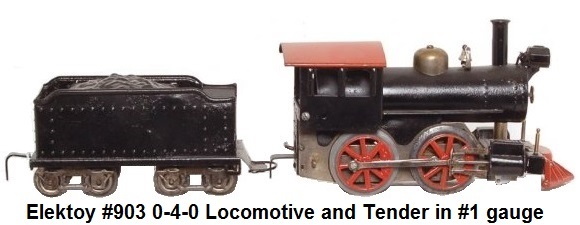 The #903 steam outline loco was finished in gun-metal, as was its tender. It had a shorter boiler than the #905 and one less
sand dome. However, it used the same frame and drive mechanism as the #905. The #903 boiler, cab and tender body were made
of sheet steel. Early #903's were equipped with a coal bunker and no tender was provided. The later #903's may have come
with a very rare 4-wheel coal tender or the more common 8-wheel coal tender. The 4-wheel tender was described as a simple
3-sided sheet steel wrapper soldered to a #906 dump car frame and painted black. It had no rivet detail or lettering.
The #905 had a polished brass boiler, and solid brass parts throughout. It came in an unpainted natural finish, with a
nickel plated cab and nickel plated chassis component parts, including details such as an air
compressor, hand rails, and running boards. The tender also had an
unpainted natural brass finish. Elektoy promoted the product with a statement in the 1913 catalog that, "There
is nothing like it on the market at double cost." The retail price was $9.00, including the tender and a circle of track.
The #903 steam outline loco was finished in gun-metal, as was its tender. It had a shorter boiler than the #905 and one less
sand dome. However, it used the same frame and drive mechanism as the #905. The #903 boiler, cab and tender body were made
of sheet steel. Early #903's were equipped with a coal bunker and no tender was provided. The later #903's may have come
with a very rare 4-wheel coal tender or the more common 8-wheel coal tender. The 4-wheel tender was described as a simple
3-sided sheet steel wrapper soldered to a #906 dump car frame and painted black. It had no rivet detail or lettering.
The #905 had a polished brass boiler, and solid brass parts throughout. It came in an unpainted natural finish, with a
nickel plated cab and nickel plated chassis component parts, including details such as an air
compressor, hand rails, and running boards. The tender also had an
unpainted natural brass finish. Elektoy promoted the product with a statement in the 1913 catalog that, "There
is nothing like it on the market at double cost." The retail price was $9.00, including the tender and a circle of track.
Passenger and freight cars were basic, looking a bit like a cross between Lionel's smaller series standard
gauge cars and Ives lithographed #1 gauge cars. The cars were painted and had rubber stamped roadnames
and details.

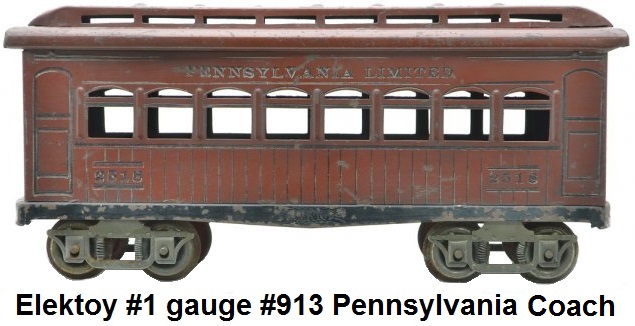
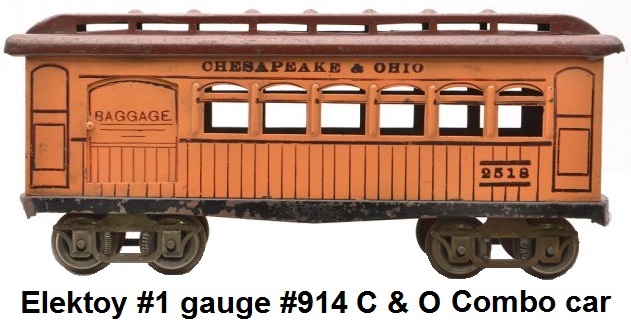
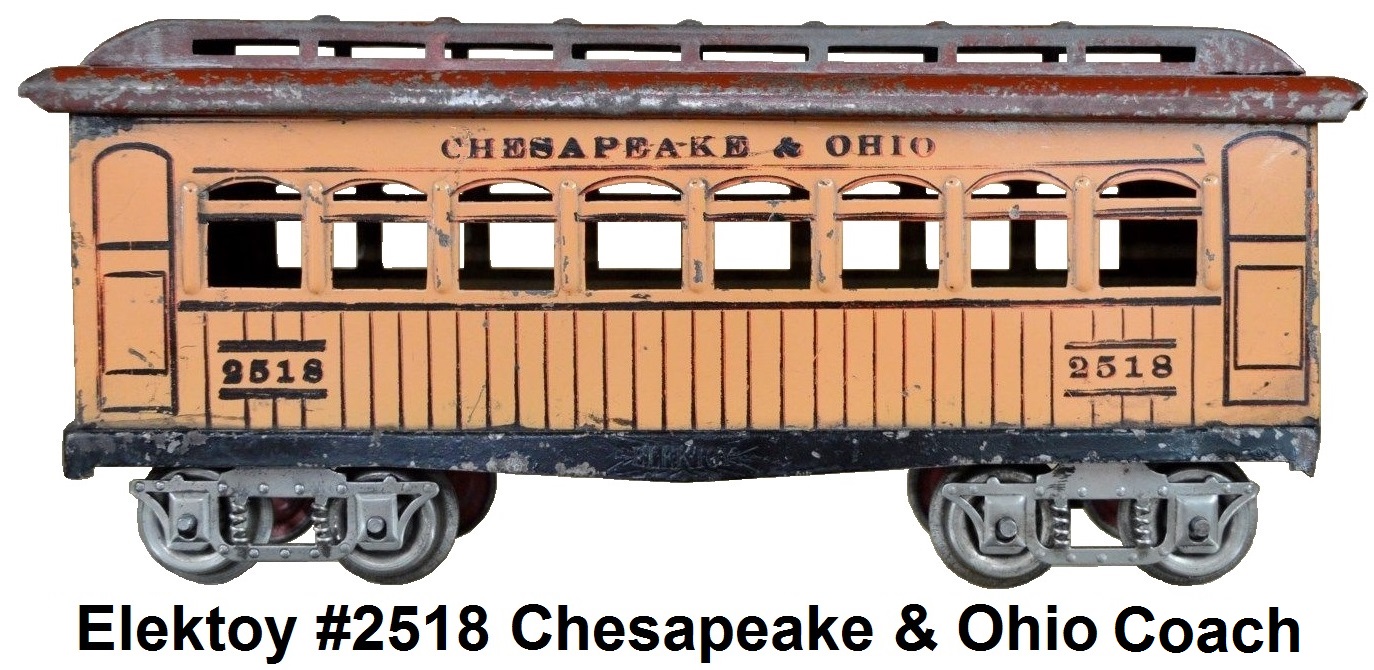
Elektoy passenger cars were primarily made in three 11" types - a #913 coach, a #915 Pullman,
and a #914 combine. The coach was available in orange painted litho with a Cheseapeake and Ohio road name, in
a maroon and tuscan painted litho with the Pennsylvania Limited lettering, or in blue painted
litho with the New York Phila Balto Washington lettering. The #915 Pullman was offered in orange labeled as
the Richmond, in dark red lettered Electro, and in maroon and tuscan, also lettered Electro. The #914 combine
car provided the most variety of choices, offered up in yellow with the liveries
of the New York Phila Balto Washington, or in red with the same road name, in orange as Chesapeake and Ohio,
or in dark red as the Pennsylvania Limited, in maroon and tuscan with either Pensylvania Limited or New York
New Haven and Hartford, or in blue with New York Phila Balto Washington. It was very common for Elektoy to
issue their passenger sets with mixed cars of different road names and colors. Only one set, the Pennsylvania
Limited in maroon and tuscan came with matching cars. All passenger cars were equipped with two 4-wheel trucks, and
for some unknown reason, were always labelled with the #2518. The coach and combine cars had windows punched out,
but the doors had lithographed windows. The Pullman car, always had cut out windows over the doors, nickel air
tanks and an electric light. This was the fanciest car and retailed at $2.50, a dollar more than the combine or
coach which cost $1.50. These passenger cars were outfitted with simulated sprung trucks (freight cars utilized
the same trucks, but without the springs), but no individual couplers. Passenger cars were joined using two
couplers riveted together loosely enough to flex when the trains were traversing curved tracks. Theses couplers
were never permanently attached to the car bodies. A very rare set of smaller 8" passenger cars was
catalogued as #937, and used the same body as the #901 trolley. These came painted in a light bluegray color,
and were lettered for the NYNH&H.

Instructions advised the use of dry cell batteries at 4 to 6 volts to power the trains. The motors
pulled one amp. The 1912 catalog stated "transformers are discouraged and are found in practice to be unsatisfactory and
dangerous." A rheostat controller was available for 50¢ that featured an automatic spring lever cut-off mechanism
which prevented track power from being left on, similar to the dead-man control found in real electric locomotives and
rail cars.
Elektoy produced eight different
freight cars: a #906 operating dump car, a #907 hopper, a #908 combination lumber/flat car with removable stakes,
 a #909 gondola/gravel car, a #910 stock car, a #911 box car, a #912 caboose, and a #938 tank car. These cars were
all equipped with nickel trucks and brake wheels. The #906 dump car only had 4 wheels, and was available
in either red or yellow paint. The dump bin could be tilted to dump the load. The remainder of the freight
cars were equipped with 2 four wheel trucks. The #907 hopper and #908 flat cars both came in
black. The #909 gondola was offered in red or yellow, but brown ones have been discovered. The #910
stock car came painted in red or yellow enamel, and was available with either a brown or gray roof, it also
had sliding doors. The stock car measured 9¾" long by 2¾" wide by 4¾" high.
The #911 box car came in either red, yellow or orange enamel paint and was also equipped with
sliding doors. It was lithographed as either a 'Fast Freight' for one of these lines: Pennsylvania
Lines, Union Lines, New York Central Lines, or NYC and HRR, or can be found as a "Refrigerator -
Dairy Products Express" with Despatch Transportation Company lettering. The box car measured 9¾" long by
2¾" wide by 4¾" high. The #912 caboose was offered
in red or yellow with Pennsylvania Lines markings. The #938 oil tank car was only
found in red. Elektoy offered the #907 hopper in two road names: Keystone and CPR of New Jersey.
These freight cars were outfitted with a patented set of couplers that were riveted to the oar
underframe of each car. The unique design employed a long T and V male coupler (one on each car)
that engaged a body slot in the adjoining car. The name Elektoy was embossed on all car and tender frames. The
Elektoy 1912 catalog lists the prices for the #910 stock car and the #911 box car as $1.00.
a #909 gondola/gravel car, a #910 stock car, a #911 box car, a #912 caboose, and a #938 tank car. These cars were
all equipped with nickel trucks and brake wheels. The #906 dump car only had 4 wheels, and was available
in either red or yellow paint. The dump bin could be tilted to dump the load. The remainder of the freight
cars were equipped with 2 four wheel trucks. The #907 hopper and #908 flat cars both came in
black. The #909 gondola was offered in red or yellow, but brown ones have been discovered. The #910
stock car came painted in red or yellow enamel, and was available with either a brown or gray roof, it also
had sliding doors. The stock car measured 9¾" long by 2¾" wide by 4¾" high.
The #911 box car came in either red, yellow or orange enamel paint and was also equipped with
sliding doors. It was lithographed as either a 'Fast Freight' for one of these lines: Pennsylvania
Lines, Union Lines, New York Central Lines, or NYC and HRR, or can be found as a "Refrigerator -
Dairy Products Express" with Despatch Transportation Company lettering. The box car measured 9¾" long by
2¾" wide by 4¾" high. The #912 caboose was offered
in red or yellow with Pennsylvania Lines markings. The #938 oil tank car was only
found in red. Elektoy offered the #907 hopper in two road names: Keystone and CPR of New Jersey.
These freight cars were outfitted with a patented set of couplers that were riveted to the oar
underframe of each car. The unique design employed a long T and V male coupler (one on each car)
that engaged a body slot in the adjoining car. The name Elektoy was embossed on all car and tender frames. The
Elektoy 1912 catalog lists the prices for the #910 stock car and the #911 box car as $1.00.
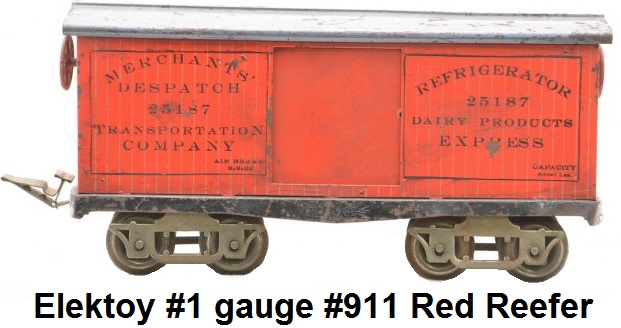
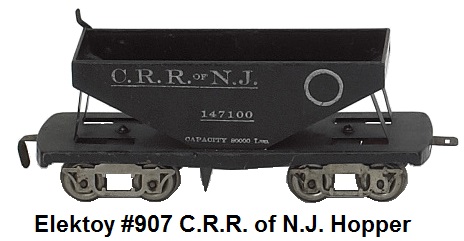

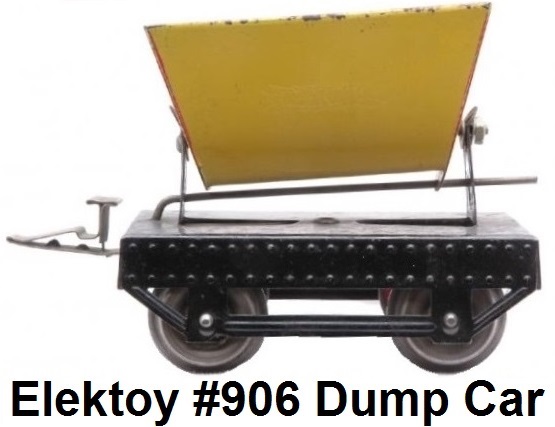
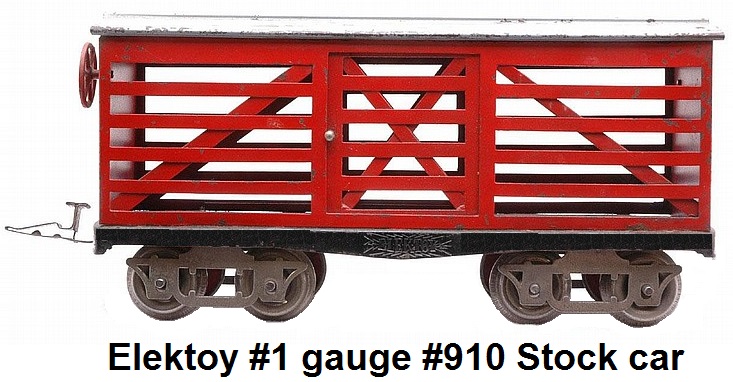

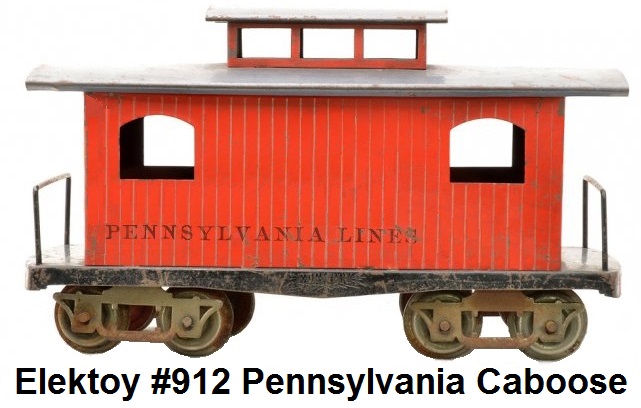
Heavy tinned steel was utilized in the manufacture of the Elektoy 3-rail #916 track.
The inside rail was insulated from the metal sleepers/cross ties using hard fibre (not paper). Straight sections
were 12" long. The 1912 catalog proclaimed that, "straight sections were 1½" to 2" longer than the average track of
other makers." Elektoy track utilized a patented third rail curved clip connector. There was one of these clips
on each end of the center rail of each track section, enabling the ability to reverse the sections without having to
remove track pins. The curved track was made in two diameters, 8 sections of one diameter made a 30" circle, and
10 sections of the other diameter made a 38" circle. Track was priced at 15¢ per piece, straight or curved.
Elektoy also produced their #917 left and right hand switch tracks, a #918 45° crossover and a #919 bumper.

Elektoy is known to have catalogued 13 different complete ready to run train set outfits, but not until
1913. The sets came with a circle of #916 track and a #920 automatic cut-off controller in partitioned cardboard boxes. The
catalogued sets were:
Freight outfit #922 which consisted of the #921 electric outline loco and 3 #906 4-wheel dump cars
priced at $6
#923 freight set that contained a #921 loco, #900 lumber flat, and 2 #909 gravel cars, priced at $6.75
#924 passenger set which had a #934 reversible loco, and 3 special passenger cars, priced at $8
#925 freight set featuring a #934 reversible loco, #911 box car, #910 stock car, #909 gravel car and #912 caboose for
$8.50
#926 freight set with a #903 locomotive and tender, #909 gravel car, #911 box car, #906 lumber car, #912 caboose, priced at
$10
#927 coal train featuring a #903 loco and tender and 4 #907 coal hoppers, priced at $10.50
#928 containing a #903 loco with tender, 2 #911 box cars, 1 #910 stock car, and a #912 caboose priced at $11
Passenger set #929 featuring a #934 locomotive, 2 #913 coaches and 1 #914 combo car priced at $10.50
Passenger outfit #930 containing a #934 electric loco, 2 #915 Pullman cars and a #914 combo baggage car for $12.50
Passenger set #931 consisting of a #905 nickel plated loco and tender, 2 #913 coaches, a #914 combo car priced at $14
Passenger outfit #932 featuring a #905 loco and tender, 2 #915 Pullman coaches, a #914 combo car, for $16
Deluxe passenger outfit #933 featuring a #905 loco and tender, 2 #913 coaches, 3 #915 Pullman cars, a #918 45°
crossover, a #917 right hand switch track, a #917 left hand switch track, and a #919 track bumper, priced at $25
Freight set #936 with a #904 electric loco, #910 stock car, #911 box car, #912 caboose for $9.50
In 1911
and 1912 it is believed that train sets were not catalogued, only individual train cars and locomotives were listed.

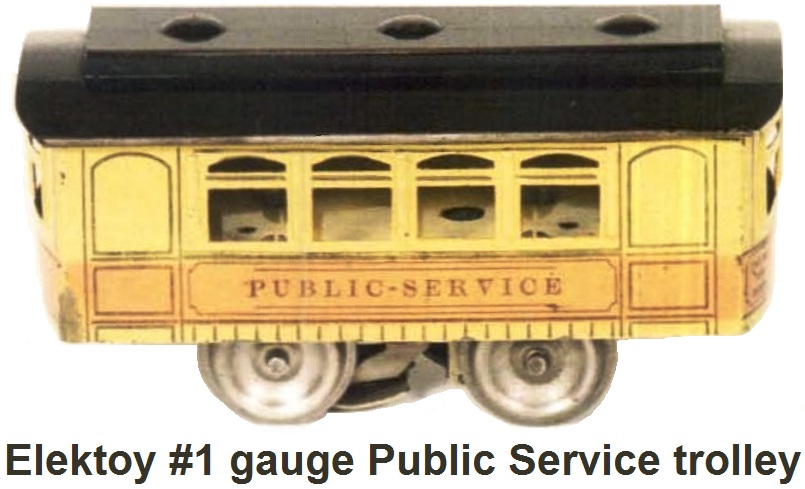 Elektoy catalogs picture several items which may never have actually been produced, or that were produced in very small
quantities, but were not sold widely, since these items have rarely shown up in collections. Among these are the #937 small
special passenger car, #921 shorter electric type locomotive, #903 tank steam type loco lettered #976
(similar to a Lionel #5), #901 4-wheel trolley, and the #902 8-wheel twin motor trolley, both lettered 'PUBLIC SERVICE',
the latter using a standard Elektoy passenger car body. Also rumored to exist but not proven are the #910 orange livestock,
#912 orange caboose and #938 yellow oil car. It is unknown how much the small Elektoy switcher sold for because it was not
cataloged. There are only 6 of these locomotives known to exist.
Elektoy catalogs picture several items which may never have actually been produced, or that were produced in very small
quantities, but were not sold widely, since these items have rarely shown up in collections. Among these are the #937 small
special passenger car, #921 shorter electric type locomotive, #903 tank steam type loco lettered #976
(similar to a Lionel #5), #901 4-wheel trolley, and the #902 8-wheel twin motor trolley, both lettered 'PUBLIC SERVICE',
the latter using a standard Elektoy passenger car body. Also rumored to exist but not proven are the #910 orange livestock,
#912 orange caboose and #938 yellow oil car. It is unknown how much the small Elektoy switcher sold for because it was not
cataloged. There are only 6 of these locomotives known to exist.
 The Elektoy Trains were only sold wholesale to just five main distributors located in New York, Philadelphia,
Chicago, St. Louis, and San Francisco. Only these five distributors supplied catalogs of the line through their retail
small store channels. The line was not available in any of the larger better-known department stores, but instead was
found in the smaller neighborhood electrical and hardware stores. Around these five train distributor outlets, and near
them, is where Elektoy was sold, and is still being discovered. For example, some occasionally turns up in the St. Louis
vicinity near where the Linze Electrical Supply Company (1217 Olive Street), one of the distributors, was located.
The 1913 catalogue emphasizes that "the manufacturers do not sell goods at retail, order from your dealer".
The Elektoy Trains were only sold wholesale to just five main distributors located in New York, Philadelphia,
Chicago, St. Louis, and San Francisco. Only these five distributors supplied catalogs of the line through their retail
small store channels. The line was not available in any of the larger better-known department stores, but instead was
found in the smaller neighborhood electrical and hardware stores. Around these five train distributor outlets, and near
them, is where Elektoy was sold, and is still being discovered. For example, some occasionally turns up in the St. Louis
vicinity near where the Linze Electrical Supply Company (1217 Olive Street), one of the distributors, was located.
The 1913 catalogue emphasizes that "the manufacturers do not sell goods at retail, order from your dealer".
In the war period of 1917-1918 train manufacture was permanently discontinued, due to rationing,
and the company faded completely from sight after World War I.
Sources for this article include:
Glen H. Harrison's writings in the TCA Collector's Quarterly October 1956
Donald S. Fraley's writings in the TCA Collector's Quarterly July 1999
Tad Cody's writings in the TCA Collector's Quarterly July 1986
